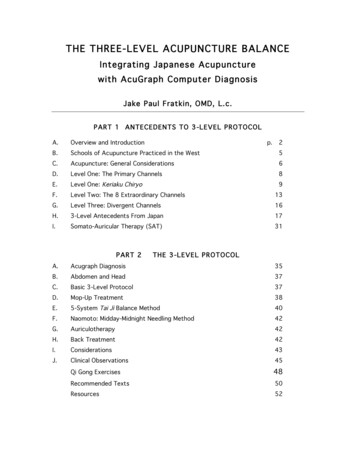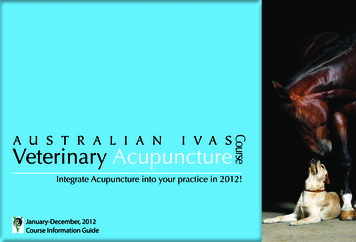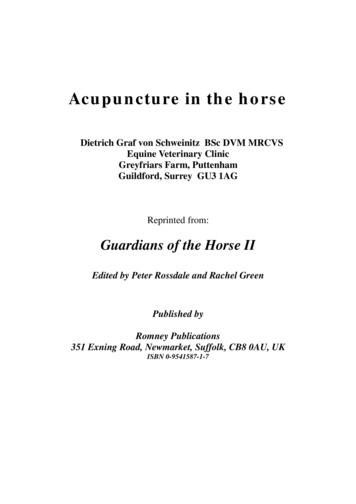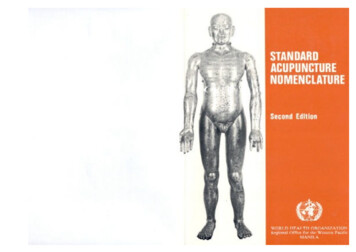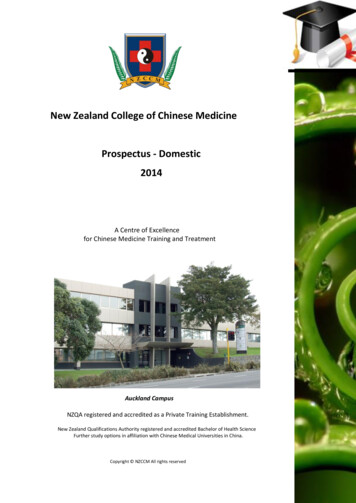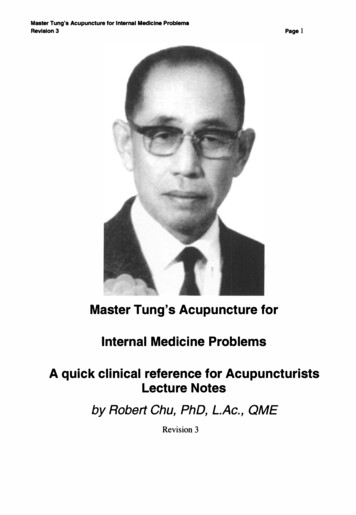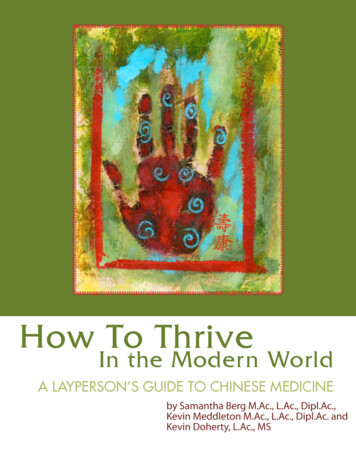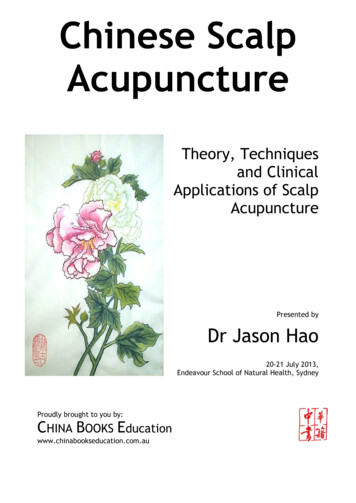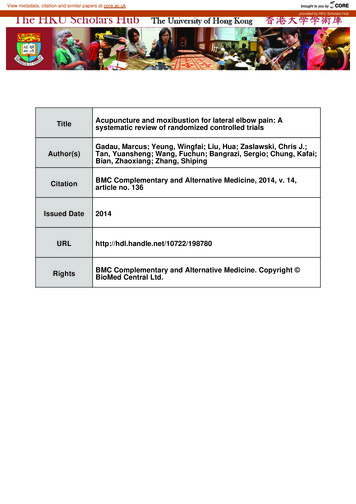
Transcription
View metadata, citation and similar papers at core.ac.ukbrought to you byCOREprovided by HKU Scholars HubTitleAuthor(s)CitationIssued DateURLRightsAcupuncture and moxibustion for lateral elbow pain: Asystematic review of randomized controlled trialsGadau, Marcus; Yeung, Wingfai; Liu, Hua; Zaslawski, Chris J.;Tan, Yuansheng; Wang, Fuchun; Bangrazi, Sergio; Chung, Kafai;Bian, Zhaoxiang; Zhang, ShipingBMC Complementary and Alternative Medicine, 2014, v. 14,article no. 1362014http://hdl.handle.net/10722/198780BMC Complementary and Alternative Medicine. Copyright BioMed Central Ltd.
Gadau et al. BMC Complementary and Alternative Medicine 2014, 6RESEARCH ARTICLEOpen AccessAcupuncture and moxibustion for lateral elbowpain: a systematic review of randomizedcontrolled trialsMarcus Gadau1,8†, Wing-Fai Yeung2†, Hua Liu3, Chris Zaslawski4,8, Yuan-Sheng Tan5,8, Fu-Chun Wang6,8,Sergio Bangrazi7,8, Ka-Fai Chung2, Zhao-Xiang Bian1 and Shi-Ping Zhang1,8*AbstractBackground: Acupuncture and moxibustion have widely been used to treat lateral elbow pain (LEP). Acomprehensive systematic review of randomized controlled trials (RCTs) including both English and Chinesedatabases was conducted to assess the efficacy of acupuncture and moxibustion in the treatment of LEP.Methods: Revised STRICTA (2010) criteria were used to appraise the acupuncture procedures, the Cochrane risk of biastool was used to assess the methodological quality of the studies. A total of 19 RCTs that compared acupuncture and/or moxibustion with sham acupuncture, another form of acupuncture, or conventional treatment were included.Results: All studies had at least one domain rated as high risk or uncertain risk of bias in the Cochrane risk of bias tool.Results from three RCTs of moderate quality showed that acupuncture was more effective than sham acupuncture.Results from 10 RCTs of mostly low quality showed that acupuncture or moxibustion was superior or equal toconventional treatment, such as local anesthetic injection, local steroid injection, non-steroidal anti- inflammatory drugs,or ultrasound. There were six low quality RCTs that compared acupuncture and moxibustion combined with manualacupuncture alone, and all showed that acupuncture and moxibustion combined was superior to manual acupuncturealone.Conclusion: Moderate quality studies suggest that acupuncture is more effective than sham acupuncture.Interpretations of findings regarding acupuncture vs. conventional treatment, and acupuncture and moxibustioncombined vs. manual acupuncture alone are limited by the methodological qualities of these studies. Future studieswith improved methodological design are warranted to confirm the efficacy of acupuncture and moxibustion for LEP.Keywords: Epicondylitis, Tennis elbow, Randomized Controlled Trials (RCTs), STRICTA, PRISMA, Cochrane risk of biastool, Chinese literatureBackgroundLateral elbow pain (LEP), commonly known as tenniselbow, is a common disorder with a prevalence of atleast 1-3% [1]. It is a significant health burden becauseit affects work productivity and the quality of life ofLEP sufferers. Currently there is no ideal treatment forLEP. The most common treatments for LEP are steroid* Correspondence: spzhang@hkbu.edu.hk†Equal contributors1School of Chinese Medicine, Hong Kong Baptist University, Hong Kong, SAR,China8From the Tennis Elbow Acupuncture International Study-China, Hong Kong,Australia and Italy (TEA-IS-CHAI) groupFull list of author information is available at the end of the articleinjections, non-steroidal anti-inflammatory drugs (NSAIDs)or a regime of physiotherapy with various modalities[2]. Steroid injections have a short-term (two to six weeks)effect in improving symptoms [3], whereas NSAIDs havea smaller effect than steroid injections [4]. Evidence islacking for the efficacy of physiotherapy [5]. Furthermore,there is no evidence regarding the efficacy in the longterm use of current conservative treatment options,and the potential side effects such as skin atrophy anddepigmentation [6] limit the use of steroid injections.The need for a safe and effective treatment for LEP istherefore paramount. 2014 Gadau et al.; licensee BioMed Central Ltd. This is an Open Access article distributed under the terms of the CreativeCommons Attribution License (http://creativecommons.org/licenses/by/2.0), which permits unrestricted use, distribution, andreproduction in any medium, provided the original work is properly credited. The Creative Commons Public DomainDedication waiver ) applies to the data made available in this article,unless otherwise stated.
Gadau et al. BMC Complementary and Alternative Medicine 2014, 6Acupuncture is a popular form of complementary andalternative medicine for treating pain and dysfunctionassociated with musculoskeletal conditions [7], includingLEP. In traditional Chinese medicine (TCM), acupuncture and moxibustion are two inseparable therapeuticmethods; the former stimulates the acupoint with a needle whereas the latter with heat generated by burning ofmoxa (Artemisia Vulgaris). Acupuncture has been popularly used all over the world, but it is still not recognizedas a standard treatment for LEP because the evidencesupporting its efficacy is still limited. In the most recentreview on the topic, Buchbinder et al. [8] evaluated fiverandomized controlled trials (RCTs) comparing acupuncture with sham acupuncture. The authors concluded that needle acupuncture may be more effectivethan sham acupuncture in relieving pain after one treatment as well as after ten acupuncture sessions at twoweeks, but there is no difference between needle acupuncture and sham acupuncture at the 3-or 12-monthfollow-up. They also found that needle acupuncture maybe more effective at improving functional impairment at2-week follow-up compared with sham acupuncture,and electro-acupuncture may be more effective thanmanual acupuncture in reducing pain. Nevertheless, theyconcluded the acupuncture intervention as "unknown effectiveness" in their report, due to the fact that the analyzed studies were of very small sample size and hadflaws in the study design, including uncertain allocationconcealment, substantial loss to follow up and lack of assessments for potential adverse effects.Although a number of systematic reviews have beenperformed on acupuncture for LEP [4,8-10], these reviews did not include articles published in Chinese.Moreover, moxibustion, which also acts by stimulatingthe acupoints and is commonly used concurrently withacupuncture for LEP, was not included in previous reviews. Given the fact that many studies of acupunctureand moxibustion for LEP have been published in nonWestern scientific literature and have not been reviewed,the literatures identified by previous reviews may not becomprehensive enough to cover all the current evidenceof acupuncture and moxibustion for LEP. In view of this,we conducted a comprehensive systematic review onrandomized controlled trials of acupuncture and moxibustion for LEP that were published in both Chineseand Western language literatures. This review aimed tofind out if acupuncture or moxibustion alone was moreeffective than sham acupuncture or other conventionaltreatments in the treatment of LEP. We also wanted toknow if acupuncture and moxibustion combined wasmore effective than acupuncture or moxibustion alone.In addition, this review evaluated reporting of acupuncture and/or moxibustion treatment of the included studies using the revised STRICTA criteria [11].Page 2 of 19MethodsSearch strategiesA comprehensive search was performed in the followingdatabases from their inception to June 2013: CochraneNeuromuscular Disease Group Trials Register for randomized trials, the Cochrane Central Register of ControlledTrials (CENTRAL), MEDLINE, EMBASE, Latin Americanand Caribbean Health Sciences (LILACS), Allied andComplementary Medicine (AMED), Index to Chinese Periodicals of Hong Kong (HKInChiP), Chinese BiomedicalLiterature Database (CBM) and China National KnowledgeInfrastructure (CNKI). Search was also made in ClinicalTrials.gov, ProQuest Digital Dissertations (PQDD), BIOSISPreviews, Chinese Clinical Trial Register (ChiCTR), andElectronic Theses and Dissertations System of Taiwan for“gray literature”, such as unpublished studies, dissertationsand conference reports. The following terms were used inour search strategies: (moxibustion or acupuncture orelectro-acupuncture or needle) and (lateral epicondylitis or,lateral epicondylalgia, or tennis elbow, or lateral epicondyle, or external humeral epicondylitis, or brachioradialbursitis, or lateral elbow pain, or lateral elbow). EquivalentChinese terms were used in searching the Chinese language databases. We imposed no language restrictions. Wefollowed the Preferred Reporting Items for Systematic Reviews and Meta-Analyses (PRISMA) in reporting this systematic review [12].Study selectionTwo authors (MG and WFY) searched the databases andassessed potentially relevant articles against the inclusioncriteria independently. Any disagreement regarding theeligibility of a study was resolved by discussion.Types of studies and subjectsWe included only randomized controlled trials studyingsubjects with a primarily diagnosis of lateral epicondylitisor lateral elbow pain, in which acupuncture, moxibustion,or acupuncture and moxibustion combined was used fortreatment.Types of interventionsAcupunctureAcupuncture is defined as needle acupuncture, includingelectro-acupuncture and auricular acupuncture thatemployed needle penetration. Other variants of acupuncture, such as acupressure, acupoint injection, laseracupuncture, auricular acupressure, and transcutaneouselectrical nerve stimulation (TENS) were excluded.Treatments that used acupotomy (small needle-scalpeltherapy) were also excluded.
Gadau et al. BMC Complementary and Alternative Medicine 2014, 6MoxibustionMoxibustion is defined as burning of moxa either directly or indirectly over acupoints. In direct moxibustion,the moxa is placed directly over the skin. In indirectmoxibustion, the burning moxa is positioned over theacupoint, either held by an apparatus, or placed over apiece of herbal material, such as ginger or biscuit madefrom medicinal herbs.Acupuncture and moxibustion combined (AMC)We also included studies of combining acupuncture andmoxibustion treatment (acupuncture and moxibustioncombined, AMC) which is usually done by placing amoxa block on the handle of the acupuncture needle orplacing a moxa-cone on top of a thin piece of ginger-slice.Studies using acupuncture or moxibustion in combinationwith other treatments, such as medication, massage, cupping, physiotherapy, traditional Chinese herbs, or injectionwere not included.Types of control interventionsFor control interventions, we included studies that usedother standard therapies, such as injection of Westerndrugs, physiotherapy, oral Western medication, shamacupuncture, or no treatment. We also included studiesthat compared AMC with either acupuncture or moxibustion alone. However, we did not include studies thatcompared the same intervention with different combinations of acupoints, as acupoint specificity was not thefocus of this review.Data extractionOne author (MG) extracted the data and the other(WFY) checked the extracted data. For each study, thefollowing variables were extracted: study design, patients’characteristics including gender, age, duration of illness,treatment regime, control intervention, and outcomemeasures and adverse events reported.Primary outcomes extracted included measures on painand function. Secondary outcomes extracted includedmeasures on quality of life. The details of acupuncture procedure were extracted according to the revised STRICTA[11], which covered acupuncture rationale, needling details,treatment regime, other components of treatment, practitioner background, and control intervention.Methodological quality assessmentThe methodological quality of identified studies wasassessed by two authors (MG and WFY) independentlyusing the Cochrane risk of bias tool [13]. The Cochranerisk of bias assessment has 6 domains: random sequencegeneration, allocation concealment, blinding of participants and outcome assessors, complete collection andreporting of outcome data, free of selective outcomePage 3 of 19reporting, and adequate attention to other sources of bias.Each domain was rated as “low” (low risk of bias), ‘high’(high risk of bias), or ‘unclear’ (uncertain risk of bias). Giventhe difficulties in blinding the acupuncturist, we onlyassessed the blinding of participants and outcome assessors.According to a recent report by Wu et al. [14], a largeproportion of RCTs in Chinese language reports are nottruly randomized. Therefore a telephone inquiry to thefirst authors, and, if they were not available, to the second authors, was conducted to find out how many ofthem truly met acceptable standards for allocating participants to study groups.Statistical analysisWe used Review Manager Software 5.1 for statistical analysis. Relative risk (RR) with a 95% confidence interval(CI) was used for dichotomous outcomes. Mean difference(MD) with a 95% CI was used for continuous outcomes.Publication bias would be assessed by drawing a funnelplot if there were ten studies or more included in themeta-analysis. Meta-analysis would only be performed, ifstudies had no domain rated as having high risk of bias bythe Cochrane risk of bias assessment and had sufficientsimilarities in clinical characteristics [13].ResultsSelection of studiesThe search identified 580 English and 1239 Chinese potentially relevant citations for review. After removal of duplicates, 232 English and 1036 Chinese citations were left.There were 206 English and 866 Chinese papers excludedfor reasons of irrelevance (Figure 1). One hundred ninetysix full-text articles were retrieved for further assessment.Two studies were duplicated publications [15,16]. Finally,19 studies (14 Chinese, four English, one Italian) met theinclusion criteria and were included in this review.Description of included studiesAll 19 included studies were full length journal reports. Ofthe 19 studies, 14 were published in Chinese and wereconducted in China; four were published in English, threeof which were conducted in Germany [15-17] and onewas conducted in Canada [18]. The remaining study wasconducted in Italy and published in Italian [19]. Togetherthese studies involved a total of 1190 subjects, with 688being in the treatment arm and 502 in the control arm.All included trials used a two-armed, parallel group design, except for the Shen et al. study [20], which used athree-armed, parallel group design.The sample size of the included studies ranged from16 to 120 subjects. All subjects were out-patients, withan age range from 17 to 74 years in the treatment armand 20 to 76 years in the control arm. The terminologyused for LEP varied between studies. Twelve studies
Gadau et al. BMC Complementary and Alternative Medicine 2014, 6Page 4 of 19Figure 1 Flow chart of study selection.[18-29] used the term lateral epicondylitis, whereas theterm tennis elbow was used by four studies [30-33] todescribe the condition. One study used both terms in itstitle, but in the text consistently used the term lateralepicondylitis [17]. One study used the term chronic epicondylitis [15] and the remaining study used the termchronic elbow pain [16]. We decided to use the termLEP, rather than epicodylitis as research has shown thatthe pathophysiology of tennis elbow is a breakdown ofthe tendon (tendinosis) rather than inflammation [34].In this review the term LEP refers to pain at the lateralside of the elbow region, especially to pain which originates from the lateral epicondyle. We refrained fromusing the term “chronic” due to the fact that many studies included subjects with an elbow pain duration too recent to be classified as chronic. The duration of the LEPdescribed in the included studies varied from seven daysto five years. Follow-up periods varied from one day upto one year after the last treatment. Table 1 presents thecharacteristics of all included studies.Acupuncture was compared with sham acupuncture inthree studies (Table 2). One study [16] used non-invasivesham acupuncture at BL 13 on the back, in which subjectswere stimulated with a pencil like probe and were shownan acupuncture needle. The other two studies [15,17]inserted real acupuncture needles a few centimeters awayfrom traditional acupoints, their interconnecting lines(meridians) and painful pressure points.Seven trials compared acupuncture with conventionaltherapies, of which four studies [20,21,30,31] used localinjection of steroid and/or local anesthetics as the control intervention. One [18] used pulsated ultrasound,one used pulsated ultrasound in combination with massage [19], and the remaining one [32] used meloxicamtablets as the control intervention (Table 3).Ginger-moxibustion was compared to conventionaltherapy in three trials [22,29,33] (Table 4). Two studies[29,33] used scarring moxibustion, in which the moxawas burned indirectly on the skin, and the area wasallowed to heat up to the extent of blister-formation,which would turn into fully formed scar tissue after aperiod of two to four weeks. The remaining study [22]reported to allow the moxa-cones to heat up the localarea until the skin became red and hot to touch, but notto a degree that would cause blister formation. For control treatments, Jin et al. [33] injected vitamin B1 andB12 along with lidocaine and prednisolone into the localsite of pain, whereas the two other studies [22,29] usedprocaine and prednisolone injections.Six [23-28] studies compared AMC with acupuncturealone (Table 5). One study [20] compared AMC withelectro-acupuncture and local injection of prednisoloneusing a three-arm design, and its results are presented inboth Tables 3 and 5.Description of acupuncture, moxibustion andacupuncture and moxibustion combined (AMC) regimesAcupuncture alone was used in ten studies, of whichnine [15-19,21,30-32] used manual stimulation and onestudy [20] employed electro-acupuncture. Moxibustion
1st Author (year)Design, Follow-upDetails of interventionChen (2010) [30]2 parallel arms, follow-upduration not reportedTreatment groupControl groupTreatment groupControl groupAcupuncture, 1treatment every 3days for 15 daysTriamcinolone acetonideinjection, 1 treatmentevery 5 days for 15 daysLocal tender points, superficial,strong manual manipulation,needles retained for 1 min.Triamcinolone acetonide 40 mg,2% lidocaine 2 ml injected atarea of painDavidson (2001) [18]2 parallel arms, follow-upduration not reportedAcupuncture, 2–3treatments perweek for 4 weeksUltrasound, 2–3 treatmentsper week for 4 weeksLI 4, SJ 5, LI 10, LI 11, LI 12,manual manipulation to obtainand maintain De-qi, needlesretained for 20 min.Pulsated ultrasound for 10 min.over area of lateral epicondyleFink (2002) [15]2 parallel arms, 2 monthsAcupuncture, 2treatments perweek for 5 weeksSham-acupuncture, 2treatments per weekfor 5 weeks1 local tender point, LI 10, LI 11,LU 5, LI 4 and SJ 5, manualmanipulation to obtain De-qi,needles retained for 25 min.Same as treatment group, butneedles placed at least 5 cmaway from real acupoint, areaclear of tender pointsGrua (1999) [19]2 parallel arms, follow-upduration not reportedAcupuncture, 1–2treatments perweek for approx. 5weeks (total of 10treatments)Ultrasound, massage,1 treatment per day for12 daysLI 4, LI 10, LI 11, LI 12, LI 15, PC 5,PC 7, GB 20, GB 21, GB 34, ST 37,ST 38, manual manipulationneedles retained for 20 min.Pulsated ultrasound for 5 min.,massage for 5 min., both at areaof lateral epicondyleIrnich (2003) [17]2 parallel arms, 2 weeksAcupuncture, 3treatments for 10daysSham-acupuncture, 3treatments for 10 daysLI 4, LI 10, SI 3, SJ 5, GB 34,intermittent manual manipulationto obtain and maintain De-qi,needles retained for 25 min.Same as treatment group, butneedles placed 1 cun away fromreal acupointJin (2005) [33]2 parallel arms, 1 monthSingle scarringgingermoxibustionPrednisolone compoundinjection, 1 treatment perweek for 2 weeksLocal tender points, gingermoxibustion, 7 cones peracupoint2% lidocaine 1 ml, prednisolone1 ml, Vitamin B1 50 mg, VitaminB12 250 μg injected at area of painLi (1998) [28]2 parallel arms, follow-upduration not reportedAMC, 1 treatmentevery 1 or 2 daysfor 2 monthsAcupuncture, 1 treatmentevery 2 days for 2 monthsLocal tender points, LI 4, LI 10, LI11, AMC, manual stimulation toobtain and maintain De-qi, needlesretained for 15–20 min.,moxibustion with moxa-stickuntil local area reddenedSame as treatment group, butonly manual stimulation toobtain and maintain De-qiLi (2007) [22]2 parallel arms, follow-upduration not reportedGinger-moxibustion,1 treatment every2 days for 14 daysPrednisolone injection,1 treatment every 5–7 daysfor 14–21 daysSJ 10, LI 11, manual stimulation toobtain De-qi, needles not retained,ginger-moxibustion 5–7 cones peracupoint2% lidocaine 2 ml, prednisolone25 mg injected at area of painLiu (2008) [23]2 parallel arms, follow-upduration not reportedAMC, 1 treatmentevery 2 days for 28daysAcupuncture, 1 treatmentevery 2 days for 28 daysLocal tender points, LI 4, LI 10, LI11, SJ 5, AMC, manual stimulationto obtain and maintain De-qi,needle retained for 20–30 min.,indirect moxibustion, 3–5 conesper acupointSame as treatment group, butonly manual stimulation toobtain and maintain De-qiLin (2011) [21]2 parallel arms, 1 monthAcupuncture, 1treatment every 2days for 20 daysPrednisolone injection, 1treatment every 10 daysfor 20 daysLI 11, 1 most tender point onlateral aspect of elbow, 3 points0.5-1 cun distal to the most tenderpoint, manual manipulation toobtain and maintain De-qi, needlesretained for 30 min.Prednisolone 5 ml, 2% procaine1.5 ml injected at area of painPage 5 of 19Intervention, treatment durationGadau et al. BMC Complementary and Alternative Medicine 2014, 6Table 1 Study design of all included studies
Molsberger (1994) [16]2 parallel arms, 3 daysAcupuncture, 1treatment onlySham-acupuncture, 1treatment onlyIpsilateral GB 34, manualmanipulation to obtain andmaintain De-qi, needlesretained for 5 min.BL13 non-needle sham acupuncture,stimulation with a pencil-like probeat beginning and after 5 min.Shen (1999) [20]3 parallel arms, follow-upduration not reportedElectro-acupuncture,1 treatment per dayfor 10 daysControl 1: AMC, 1 treatmentper day for 10 daysLocal tender points, manualmanipulation to obtain De-qifollowed by electric stimulationfor 30 min., heat lamp for 30 min.Control 1: Same as treatmentgroup but AMC, needleretainment for 30 min., indirectmoxibustion (moxa stick)Control 2: Prednisolone,1 treatment per week for3 weeksControl 2: Prednisolone 20 mginjected at area of pain2 parallel arms, follow-upduration not reportedAMC, 1 treatmentper day for 10 daysAcupuncture, 1 treatmentper day for 10 daysLI 10, LI 11, SJ 10, PC 6, REN 12, ST36, SP 6, points chosen based onTCM pattern diagnosis, AMC,De-qi obtained, duration of needleretainment not reported, indirectmoxibustion 3 cones per acupointSame as treatment group, butonly manual stimulation toobtain De-qi, no additionalstimulation during treatment,duration of needle retainmentnot reportedWang (2008) [25]2 parallel arms, follow-upduration not reportedAMC, 1 treatmentevery 3 days for 30daysAcupuncture, 1 treatmentevery 3 days for 30 days5 local tender points, LI 4, AMC,even manual stimulation techniqueto obtain and maintain De-qi,needles retained for 30 min.,indirect moxibustion, 2–3 conesper acupointLI 4, LI 10, LI11, LI 12, manualstimulation every 10 min.,needles retained for 30 min.Wu (2003) [26]2 parallel arms, follow-upduration not reportedAMC, 1 treatmentevery 2 days for 14daysAcupuncture, 1 treatmentevery 2 days for 14 daysLocal tender points, LI 4, LI 10, LI11, SJ 5, manual manipulation for1 min. to obtain and maintainDe-qi, needles retained for 30 min.,indirect moxibustion 3–5 conesper acupoint1 local tender point was selected,De-qi obtained, needles retainedfor 30 min.Xu (2010) [29]2 parallel arms, follow-upduration not reportedSingle scarringginger-moxibustionPrednisolone injection,1 treatment every 5 daysfor 15 daysLocal tender points, gingermoxibustion, duration notreportedPrednisolone 25 mg, 2% procaine2 ml injected at area of painZha (2004) [31]2 parallel arms, follow-upduration not reportedAcupuncture, 1treatment every 2days for 14 daysHydrocortisone acetateinjection, 1 treatment perweek for two weeksLocal tender points, manualmanipulation, duration of needleretainment not reported2% lidocaine 5 ml,hydrocortisone-acetate 125 mg(1 ml) injected at area of pain.Zhang (2007) [32]2 parallel arms, follow-upduration not reportedAcupuncture, 1treatment every 2days for 20 daysMeloxicam tablets oralintake, 1 treatment every 2days for 20 days1 local tender point and 2 pointsat 2 cm apart from the tenderpoint, manual manipulation toobtain and maintain De-qi,duration of needle retainmentnot reportedMeloxicam tablets 7.5 mg/ dayZhao (2003) [27]2 parallel arms, follow-upduration not reportedAMC, 1 treatmentper day for 10 daysAcupuncture, 1 treatmentper day for 10 daysLocal tender points, manualmanipulation to obtain andmaintain De-qi, duration of needleretainment not reported, indirectmoxibustion (moxa stick) untillocal area reddenedAcupuncture at local tenderpoints, manual stimulation,duration of needle retainmentnot reportedAMC: acupuncture and moxibustion combined.Page 6 of 19Wang (2007) [24]Gadau et al. BMC Complementary and Alternative Medicine 2014, 6Table 1 Study design of all included studies (Continued)
StudiesNumber of subjects, interventionOutcome measurementFink (2002) [15]AcupunctureSham-acupunctureStrength test (peak muscle force):N 14N 15mean SDTreatment group Control groupTreatment groupPain (VAS): mean SDDASH scores: mean SDIrnich (2003) [17]OutcomesAcupunctureSham-acupuncture Pressure pain threshold (kg/cm2):N 25N 25mean SDTreatment effectControl groupMD (95% CI)At baseline: 90.5 40.40At baseline: 77.7 36.4012.80 ( 15.26 to 40.86), P 0.37At 2 weeks FU: 128.2 41.64At 2 weeks FU: 92.75 34.7835.45 (7.42 to 63.48), P 0.01*At 2 months FU: 142.9 41.56At 2 months FU: 114.2 46.0828.70 ( 3.20 to 60.60), P 0.08At baseline: 16.46 3.10At baseline: 17.17 3.76 1.24 ( 3.74 to 1.26), P 0.33At 2 weeks FU: 8.03 4.60At 2 weeks FU: 12.28 4.14 4.25 ( 7.44 to 1.06), P 0.009*At 2 months FU: 6.01 5.09At 2 months FU: 8.73 5.03 2.72 ( 6.41 to 0.97), P 0.15At baseline: 38.08 13.66At baseline: 33.72 13.054.36 ( 5.38 to 14.10), P 0.38At 2 weeks FU: 14.38 9.35At 2 weeks FU: 25.18 13.63 10.80 ( 19.26 to 2.34), P 0.01*At 2 months FU: 11.14 13.10At 2 months FU: 18.85 13.75 7.71 ( 17.48 to 2.06), P 0.12At baseline: 3.15 0.69At baseline: 2.68 0.650.47 (0.10 to 0.84), P 0.01*At first treatment: 0.32 0.31At first treatment: 0.16 0.1760.16 (0.02 to 0.30), P 0.02*At last treatment: 0.93 0.49At last treatment: 0.63 0.420.30 (0.05 to 0.55), P 0.02*At 2 weeks FU: 1.30 0.60At 2 weeks FU: 0.66 0.490.64 (0.34 to 0.94), P 0.0001*Pain-free grip strength:At baseline: 64.7 34.00At baseline: 53.7 17.7011.00 ( 4.03 to 26.03), P 0.15mean SDAt first treatment: 7.12 8.13At first treatment: 2.47 3.144.65 (1.23 to 8.07), P 0.008*At last treatment: 21.54 14.35At last treatment: 8.53 9.0513.01 (6.36 to 19.66), P 0.0001*At 2 weeks FU: 27.95 15.66At 2 weeks FU: 7.4 7.9020.55 (13.67 to 27.43), P 0.00001*At baseline: 7.72Calculation of MD not possibleImpairment caused by pain (NRS): At baseline: 8.19At first treatment: 1.57Gadau et al. BMC Complementary and Alternative Medicine 2014, 6Table 2 Outcomes of randomized controlled trials comparing acupuncture and sham acupunctureAt first treatment: 0.80At last treatment: 4.31At last treatment: 2.04*At 2 weeks FU: 4.77 (59% meandecrease in impairment causedby pain)At 2 weeks FU: 1.88* (24% meandecrease in impairment causedby pain)Page 7 of 19
Molsberger (1994) [16] AcupunctureN 24Sham-acupuncture 11-point box pain scale (NRS):Immediately after treatment:Immediately after treatment:N 2455.8% (2.95) mean pain reduction, 15.0% (2.77) mean pain reduction, 40.80 (39.18 to 42.42), P 0.001*19/24 subjects reported pain relief 6/24 subjects reported pain reliefof 50% (NRS 5)of 50% (NRS 5)*: P 0.05 statistically significant difference between two groups.DASH score, Disability of the Arm, Shoulder and Hand score; FU, follow-up; NRS, Numeric Rating Scale; SD, Standard Deviation; MD, Mean Difference; RR,Relative Risk; VAS, Visual Analogue Rating Scale.MD (95% CI)RR (95% CI) 3.17 (1.53 to 6.52),P 0.002*Gadau et al. BMC Complementary and Alternative Medicine 2014, 6Table 2 Outcomes of randomized controlled trials comparing acupuncture and sham acupuncture (Continued)Page 8 of 19
StudiesChen (2010) [30]Davidson (2001) [18]Intervention and number of subjectsOutcome measurementTreatment groupControl groupAcupunctureN 33Triamcinolone acetonide injectionN 33Pain relief and grip strength:cured rate based on subjective reportAcupunctureN 8Pulsated ultrasoundN 8Pain-free grip strength:mean SDPain Score (VAS):mean SDDASH score: mean SDGrua (1999) [19]AcupunctureN 20Pulsated ultrasound,massageN 20Maigne functional recovery test:mean SDPain Score(VAS): mean SDLin (2011) [21]Shen (1999) [20]Prednisolone injectionN 36Pain relief: VAS, cured ratebased on subjective reportElectro-acupuncture
Acupuncture and moxibustion combined (AMC) We also included studies of combining acupuncture and moxibustion treatment (acupuncture and moxibustion combined, AMC) which is usually done by placing a moxa block on the handle of the acupuncture needle or pl

